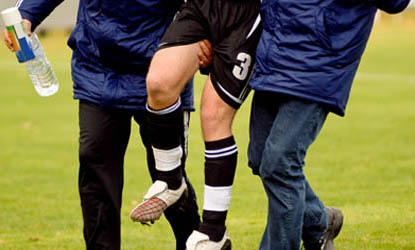Principles of Arthroscopy
During the past 3 decades, Arthroscopy has dramatically changed the Orthopaedic Surgeon’s approach to the diagnosis and treatment of a variety of Joint ailments.
A high degree of clinical accuracy combined with low morbidity has encouraged the use of arthroscopy to assist in diagnosis to determine prognasis, and often to provide treatment.
What is a Knee Arthroscopy?
The arthroscope is a small fiber optic instrument that is put into the knee joint through a small incision. A camera is used to view the inside of the knee on a TV monitor, and pictures can be taken. The arthroscope allows a complete evaluation the entire knee joint, including the kneecap(patella), the cartilage surfaces, the meniscus, the ligaments(ACL & PCL), and the joint lining.
Small instruments ranging from 3-5 millimeters in size are inserted through an additional incision so any injury can be diagnosed, and any damaged tissue can be repaired, reconstructed or removed.
Before the development of Arthroscopy, large incisions had to be made over the knee joint to treat or diagnose injuries. Today’s arthroscopic techniques allow more complete evaluations of the knee joint while accelerating the rehabilitation process.
What kind of procedures can be performed with the Arthroscope ?
Arthroscopy allows the surgeon to view the inside of the knee joint and perform a variety of surgeries. These surgeries include :
- Complete evaluation of the joint.
- Removal of damaged or torn cartilage(PARTIAL MENISCECTOMY).
- Repair of torn cartilage(meniscus repair).
- Reconstruction of torn anterior cruciate ligamant and posterior cruciate ligamant.
- Smoothing of damage to the cartilage surface in arthritis(chondroplasty).
- Realignment of patella in patellar mal-tracking (lateral release).
- Removal of joint lining(synovectomy).
- Replacement or repair of articular cartilage(cartilage transplant).
- Removal of loose fragments of bone or cartilage.

Preparing for Surgery
If you decide to have knee arthroscopy, you may need a complete physical examination with your family physician before surgery. He or she will assess your health and identify any problems.
Before surgery, tell your orthopaedic surgeon about any medications or supplements that you take. He or she will tell you which medicines you must stop taking before surgery.
To help plan your procedure, your orthopaedic surgeon may order pre-operative tests. These may include X-Rays and Blood tests.
Procedure
A cuff-like device may be put around your thigh to help control bleeding during the procedure.
The surgeon will make two or three small cuts around your knee. Salt water(saline) will be pumped into your knee to stretch the knee.
A narrow tube with a tiny camera on the end will be inserted through the cuts. Tha camera is attached to a video monitor that lets the surgeon see inside the knee.
The surgeon may put other small surgery tools inside your knee through other cuts. The surgeon will then fix or remove the problem in your knee.
At the end of your surgery, the saline will be drained out from your knee. The surgeon will close your cuts with sutures(stiiches) and cover them with a dressing.
What kind of Anesthesia is used ?
Knee arthroscopy can be performed with general anesthesia(going to sleep) or regional anesthesia(spinal or epidural block). If you have regional anesthesia, you may be able to see the procedures on a TV Monitor.
Recovery
Recovery from knee arthroscopy is much faster than recovery from traditional open knee surgery. Still, it is important to follow your orthopaedic surgeon's instructions carefully after you return home.
How should I care for my knee after surgery ?
Prior to your discharge, you will be given specific instructions on how to care for your knee.
Diet :
Resume your regular diet as soon as tolerated. It is best to start with clear liquids before advancing to solid food.
Medication :
You will be given a prescription for pain medication.
Bandage :
You will have thick dressing on the knee. You will be instructed on when it can be removed, usually in 3 days. After your dressing is removed, you should cover your sutures with a Band-Aid to protect the area from irritation.
Showering :
You may shower after your dressing is removed.
Brace :
Depending on your surgery, you may receive a brace for your knee. You will be instructed on the amount of motion allowed in the brace, and how long it is needed.
Suture removal :
Your stitches will be removed 10-12 days after surgery.
Exercise :
You will be instructed on exercise you can do immediately after surgery. You will start physical therapy within 1 to 2 weeks after surgery.
Return to work
You can return to work within 3-5 days depending upon the type of operative procedure performed.
Rehabilitation
The rehabilitation is based on several goals :
- Allowing the tissue to heal.
- Regaining motion.
- Regaining strength.
- Return to sports.
The specific rehabilitation protocol for the physical therapist will depend on the procedure performed, and will be reviewed after surgery.
When can I return to sports?
You return to sports will depend on the extent of damage and the procedure performed on your knee. You must have good motion, strength and control of your knee. How quickly you return to sports depends on several factors, including:
- Your own rate of healing.
- The damage found at surgery.
- How well you follow the post operative instruction.
- How hard you work in rehabilitation.

Our commitment :
The entire Ayushman Department of Orthropaedice and sports medicine team is committed to you, the patient. We understand that you may be anxious about your injury and the need for surgery. Please contact me with any questions about your injury or treatment plan.